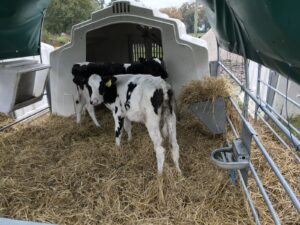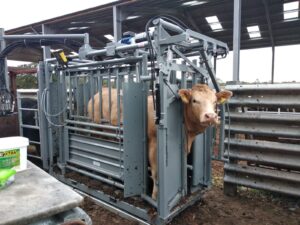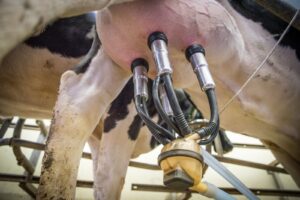Precision Livestock Farming (PLF) try to integrate cutting-edge technologies to improve livestock management.
This approach employs sensor technologies and data analytics to gather and analyze a wide range of data, from animal movement and physiological indicators to environmental conditions.
Central to PLF is Information and Communications Technology (ICT), which processes this vast data in real time and offers insights into livestock health, welfare, and productivity.
In an era where consumers increasingly prioritize sustainability and animal welfare, PLF stands out as a promising solution. However, its integration into traditional farming practices brings economic, technological, and societal challenges, raising questions about the balance between technological reliance and the intrinsic value of the human-animal bond in livestock farming.
What is Smart Livestock Farming
Precision Livestock Farming (PLF) represents an innovative approach in modern agriculture, integrating advanced technologies to enhance the efficiency and sustainability of livestock farming.
At its core, PLF is made by sensor technologies and data analytics tools. These sensors, which can be attached to animals or placed within their environment, collect a vast range of data — from movement patterns and physiological indicators to environmental conditions.
The integration of Information and Communications Technology facilitates the processing and analysis of this data, offering real-time insights into the livestock’s health, welfare, and productivity.
The significance of PLF is that it aligns with contemporary consumer demands for sustainability and animal welfare.
PLF systems contribute to more humane and welfare-oriented animal husbandry practices by enabling constant monitoring and early detection of health issues. This proactive approach improves animal health and aligns with the growing public concern for ethical and environmentally responsible food production.
Despite its potential benefits, the adoption of PLF technologies faces several challenges. Economically, the high costs of implementing and maintaining these advanced systems pose a significant barrier, particularly for small-scale farmers. The complexity of the technology itself can be daunting, requiring substantial skills in its operation and interpretation of the data it produces.
Moreover, a societal aspect must also be considered; the shift towards technology-driven farming raises concerns about the potential loss of traditional farming practices and the human-animal bond. Farmers, wary of becoming overly dependent on technology, express apprehension about losing their direct connection with the animals, a core aspect of traditional livestock farming.
Technologies Used in Smart Livestock Farming

Automated Milking Systems
These systems allow cows to be milked on demand, improving milk quality and animal welfare.
Precision Feeding Systems
These systems optimize nutrition and minimize waste, contributing to efficient feed management through tailored diets for each animal.
Wearable Health Monitors

These devices, including smart collars or ear tags, continuously track vital signs and behaviours for early illness detection and proactive health management.
Environmental Sensors
They are installed in barns and fields; these sensors monitor conditions like temperature, humidity, and air quality, ensuring optimal living conditions for livestock.
Automated Feeding and Watering Systems
These ensure timely and adequate nutrition and hydration, crucial for improving animal growth and health.
GPS and RFID Technologies
Essential for livestock tracking and management, particularly useful in extensive farming systems for location and activity monitoring.
Drones and Aerial Imagery
They provide a bird’s-eye view of pastures and herds; these tools aid in efficient land and herd management.
Farm Management Software
This software offers valuable insights for informed decision-making and streamlined farm operations, integrating data from various sources,
How Does Precision Farming Affect Animal Welfare?
Precision Livestock Farming (PLF) directly influences the welfare of farm animals in several ways. On the positive side, its real-time monitoring capabilities enable early detection of health issues, leading to prompt interventions that significantly improve animal health and comfort.
For instance, sensors that monitor movement patterns or physiological indicators can alert farmers to signs of illness, injury, or stress in animals, facilitating immediate and targeted care.
However, there are potential risks associated with PLF technologies. Introducing sensors and monitoring equipment into the animals’ environment can sometimes lead to stress or discomfort. For example, wearables or implanted devices may irritate or interfere with natural behaviours. Additionally, technical failures within PLF systems could lead to incorrect assessments or missed alerts, potentially compromising animal welfare.
Impact of PLF on Farmers and Animal Relationships
PLF also has indirect effects on the dynamic between farmers and their animals.
Using technology to monitor and manage livestock can reduce farmers’ time in direct contact with their animals. This reduction in interaction may lead to a less intuitive understanding of the animals’ needs and behaviours, potentially impacting the quality of animal care.
Balancing Increased Production Efficiency and Animal Welfare
One of the challenges in implementing PLF is balancing the drive for increased production efficiency with the maintenance of high animal welfare standards.
While PLF systems can enhance productivity by optimizing feeding, breeding, and health interventions, there is a risk that the focus on efficiency might overshadow welfare considerations.
Solutions to this include selecting and designing PLF systems that prioritize animal comfort and well-being, training farmers to interpret and act on data that benefits both productivity and animal welfare, and establishing regulatory frameworks that mandate the consideration of welfare in all PLF implementations.
PLF to Contribute to Sustainable Livestock Farming
Sustainable Farming Practices
PLF has the potential to significantly contribute to sustainable livestock farming by optimizing resource use, reducing environmental footprints, and improving the overall efficiency of farming operations.
Enhancing Animal Welfare
PLF can improve animal welfare by enabling continuous and precise animal health and behaviour monitoring. This technology can lead to early detection of health issues, better living conditions, and more personalized animal care.
Long-term Benefits
While the initial focus might be on improving efficiency and productivity, the long-term benefits of PLF include more robust, more resilient farming systems better equipped to handle environmental challenges and societal demands for sustainable practices.

Farmer’s Perspectives on PLF Technologies
a. High Costs
One of the most significant barriers to adopting Precision Livestock Farming is the high initial investment required. Advanced sensor technologies and data analytics systems come with a substantial price tag, making them less accessible, especially for small and medium-sized farms.
b. Networking
Farmers often rely on their networks – neighbors, fellow farmers, and agricultural advisors – for information about new technologies. Positive experiences within these networks can significantly boost the adoption of PLF technologies.
c. Trust in Technology
Farmers need assurance that the technology is reliable, beneficial, and will not compromise their farm’s integrity. Concerns over data privacy and cybersecurity also play into trust issues.
d. Usability and Accessibility
Technologies that are user-friendly, easy to integrate into existing farm operations, and supported by practical training and customer service are more likely to be adopted.
Strategies for Enhancing Farmer’s Technology Acceptance
a. Education and Training
Providing comprehensive education and training about the benefits and operation of PLF technologies can help mitigate fears and misunderstandings.
b. Building Trust Through Demonstrations
Showcasing successful case studies and organizing field demonstrations can help build trust. Seeing PLF technologies in action, especially on peer farms, can significantly influence farmers’ attitudes.
c. Customized Solutions
Developing PLF solutions tailored to different farming operations’ specific needs and constraints can increase their appeal. This customization could include scalability options for different farm sizes and types.
d. Support Systems
Establishing robust support systems for technical assistance, maintenance, and troubleshooting can alleviate concerns about dependency on technology and its long-term viability.
e. Engaging with Farmer Communities
Engaging with farming communities through workshops, seminars, and discussion forums can provide insights into farmers’ specific needs and concerns, leading to developing more appropriate and acceptable PLF solutions.
How to Implement Precision Livestock Farming
a. Integrated Approach
A collaborative approach where farmers, technologists, and agricultural scientists work together is the cornerstone for the effective development and implementation of PLF technologies.
Including farmers in the development process of these technologies can ensure tools are tailored to meet their needs, increasing the likelihood of adoption and successful integration into daily farming practices with a focus on animal welfare and sustainability.
b. Government Support and Subsidies
Governments will probably consider providing subsidies or financial incentives to farmers who adopt PLF technologies, easing the initial cost burden and encouraging wider adoption.
c. Education and Training Programs
Educational initiatives at agricultural colleges, through extension services, and in community settings can raise awareness about the benefits of PLF and provide necessary training to farmers and farm workers.
d. Policy Frameworks
Developing clear policy frameworks that support PLF adoption while addressing concerns such as data privacy, technology standards, and animal welfare can create a conducive environment for the growth of smart farming.
Conclusions
Precision Livestock Farming (PLF) represents a leap forward in pursuing sustainable, efficient, and welfare-oriented animal agriculture.
PLF offers a platform for enhanced animal health monitoring and management, promising productivity and animal welfare improvements. However, the journey towards its widespread adoption is challenging. High costs, technological complexities, and concerns over losing traditional farming practices and the human-animal bond present significant hurdles.
As the agricultural sector evolves, it is essential to ensure that PLF is not just a tool for efficiency but a means to genuinely uplift animal welfare standards. This balance can be achieved by designing and implementing PLF systems that prioritize animal comfort and well-being alongside the needs of farmers and the broader societal context.
Looking ahead, the success of PLF will depend heavily on collaborative efforts among farmers, technologists, scientists, and policymakers. It will require technological innovation, educational initiatives, policy support, and a strong emphasis on the ethical implications of such technologies.




